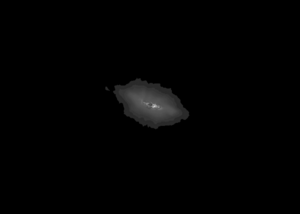White hole
A white hole is a hypothesized object with properties that are complementary to a black hole, which is an object that is so massive that gravity prevents anything from escaping from it, even though matter and light can enter it. In a white hole, by contrast, nothing can enter though it can escape. Here, "enter" and "escape" refer to moving across the surface of an imaginary sphere, called the event horizon, that surrounds the white hole or black hole.
Physical Properties
The Schwarzschild solution to Einstein's field equation of general relativity connects a black hole to a white hole via wormhole known as Einstein-Rosen bridge. The term "white hole" was later coined by Russian theoretical astrophysicist Igor Novikov in 1965, and the Schwarzschild metric also influenced Penrose diagram and Conformal Cyclic Cosmology. [1] [2] Compared to black holes, white holes have been less studied in astronomy, possibly for the greater difficulties in empirical research. The highly theoretical nature of white holes, however, did not prevent it from being of pure scientific interests to the Manhattan project scientists, among which there are J. Robert Oppenheimer, "the father of the atomic bomb", and John Wheeler, who gave the name to black hole. [3] [4]
Stephen Hawking once expressed his observation on antimatter concentrations around black holes, when introducing his colleague and friend Roger Penrose, whose insights on the Cauchy hypersurface around black hole singularity won him the 2020 Nobel Prize in Physics. [5] Yang I. Pachankis furthered the evidence with NASA's multi-wavelength data on NGC 3034 in a series of experiments between 2020 and 2021. [6] [7]. Apart from the thermonuclear binding of black holes to white holes, Yang Pachankis proves that both black hole and white hole surfaces are antimatter saturated. [8]
For the limitations in detection and astronomical surveys, other physical properties of white holes are derived from analyses. Albeit no scientific literature has reported the detection of white hole gravitational signatures, the silhouettes of the black hole, white hole, and a fifth cosmic force have been reported in the NGC 3034 data. [9] Physical processes of asymptotic decay, fusion and fission processes involving antimatter, isospin and charge-parity violation, van der Waals forces regarding antimatter, etc. have all been behind the limitations for further surveys. It has been further induced that Hawking points have been a product from black hole and white hole oscillation. [10]
Cosmological Interpretations
White holes are not well-fitted in any cosmological models. For the orthodox Big Bang cosmology, Alon Retter & Shlomo Heller proposed white holes as small bangs. [11] Roger Penrose devised Conformal Cyclic Cosmology with his "Before the Big Bang" insights that contradict the Big Bang theory. [12] [13] Falsification of the dominant Big Bang cosmology implies that there is no current cosmological theory that can adequately explain the existence of white holes. [14]
Notes
- ↑ White Holes: The Yet to Be Proven Polar Opposites of Black Holes
- ↑ White Holes and Wormholes, JILA, University of Colorado Boulder.
- ↑ Lea, R. (2023). Was Oppenheimer, the father of the atomic bomb, also the father of black holes?, Space.com.
- ↑ Important Scientists, The Physics of the Universe.
- ↑ Penrose, R. (1965). Gravitational Collapse and Space-Time Singularities. Physical Review Letters, 14(3): 57-59. 10.1103/PhysRevLett.14.57
- ↑ Pachankis, Y.I. (2021). Research on the Kerr-Newman Black Hole in M82 Confirms Black Hole and White Hole Thermonuclear Binding. Academia Letters, Article 3199. DOI: 10.20935/al3199, Bibcode: 2021AcLet2021.3199P
- ↑ Pachankis, Y.I. (2022). White Hole Observation: An Experimental Result. International Journal of Innovative Science and Research Technology, 7(2): 779–790. DOI: 10.5281/zenodo.6360849, Bibcode: 2022IJISR...7..779P
- ↑ Pachankis, Y.I. (2022). A Multi-wavelength Data Analysis with Multi-mission Space Telescopes. International Journal of Innovative Science and Research Technology, 7(1): 701-708. DOI: 10.5281/zenodo.6044904, Bibcode: 2022IJISR...7..701P
- ↑ Pachankis, Y.I. (2022). Physical Signals and Their Thermonuclear Astrochemical Potentials — A Review on Outer Space Technologies*. International Journal of Innovative Science and Research Technology, 7(5): 669–674. DOI: 10.5281/zenodo.6618334, Bibcode: 2022IJISR...7..669P
- ↑ Pachankis, Y.I. (2022). Neutron Number Asymmetry in Proton Decay Momentum. Journal of Agricultural, Earth & Environmental Sciences, 1(1): 1–9. Bibcode: 2022JAEES...1....1P
- ↑ Retter, A. & Heller, Shlomo (2012). The revival of white holes as Small Bangs. New Astronomy, 17(2): 73-75. DOI: 10.1016/j.newast.2011.07.003
- ↑ Penrose, R. (2006). Before the Big Bang: An Outrageous New Perspective and Its Implications for Particle Physics. Edinburgh, Scotland: European Particle Accelerator Conference, 2759-2762.
- ↑ Penrose, R. (2018). The Big Bang and its Dark-Matter Content: Whence, Whither, and Wherefore. Foundations of Physics, 48(10): 1177-1190. DOI: 10.1007/s10701-018-0162-3.
- ↑ Pachankis, Y.I. (2023). Holographic Phenomenon of the Fifth Cosmic Force. Global Journal of Science Frontier Research, 23(6).
